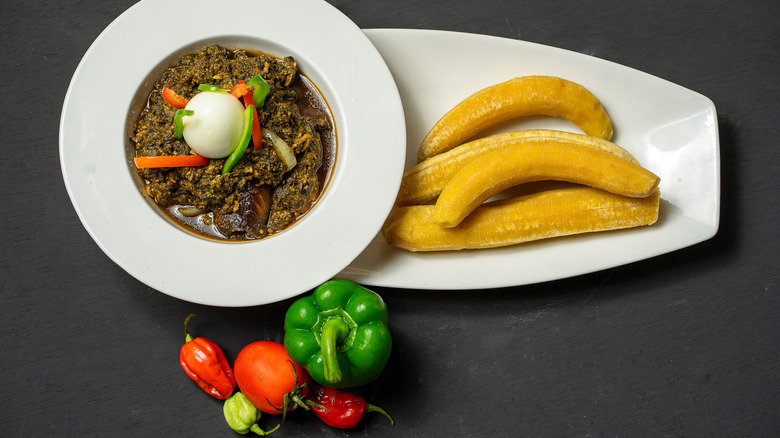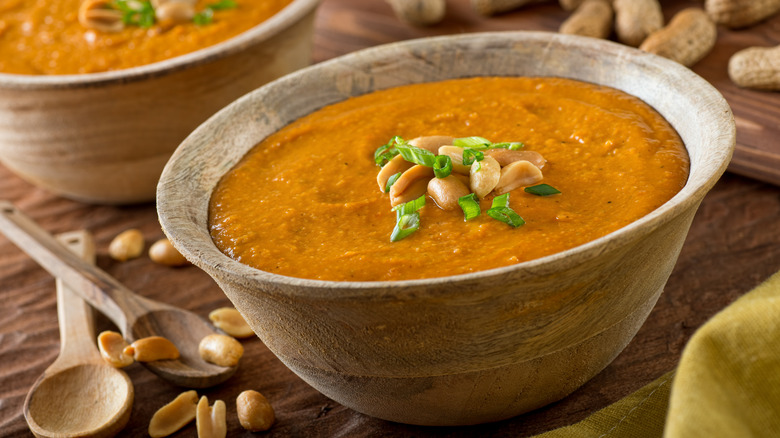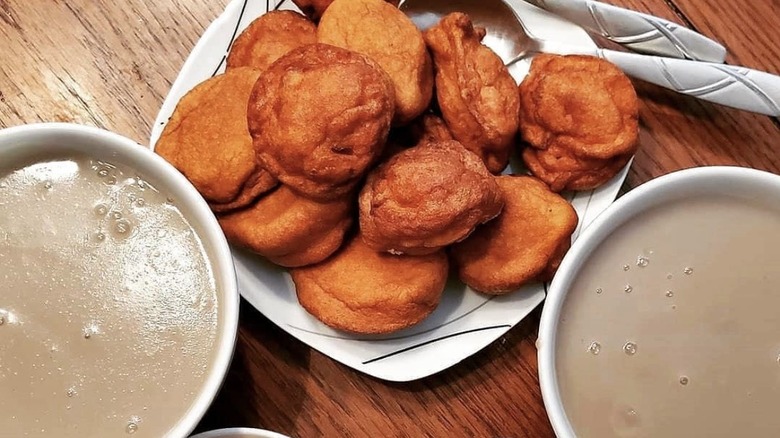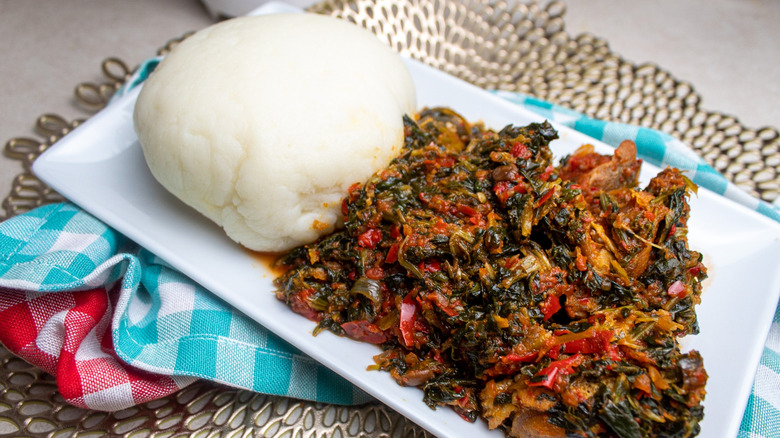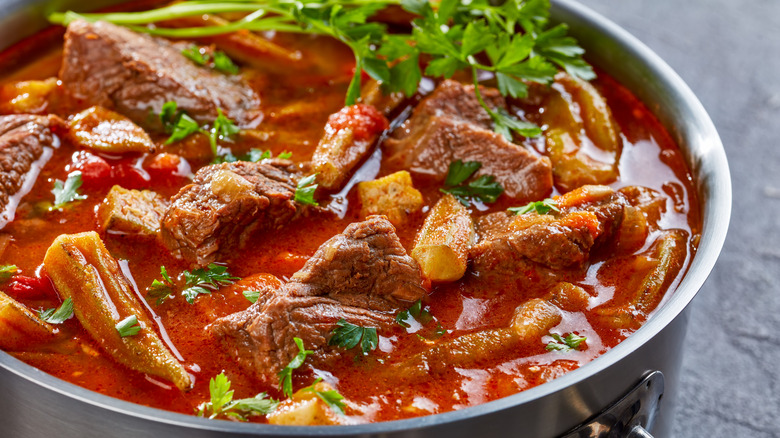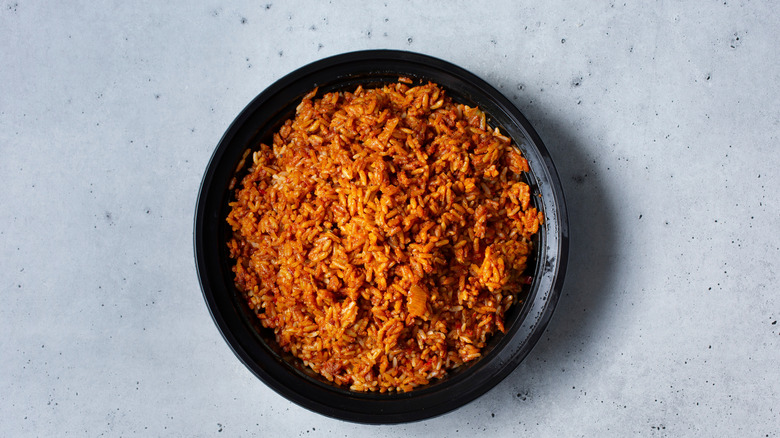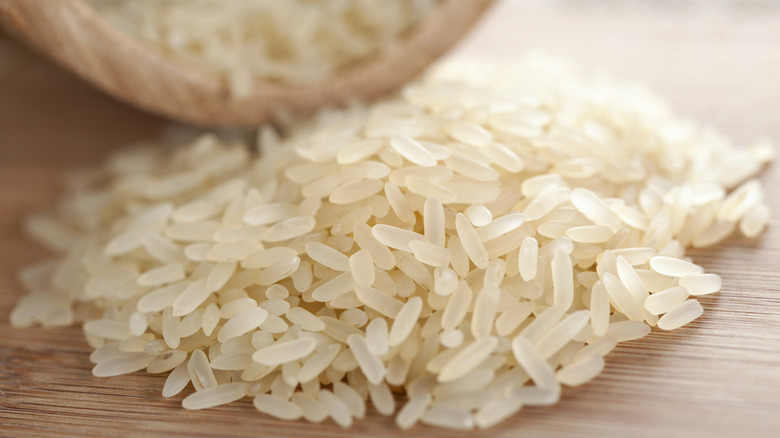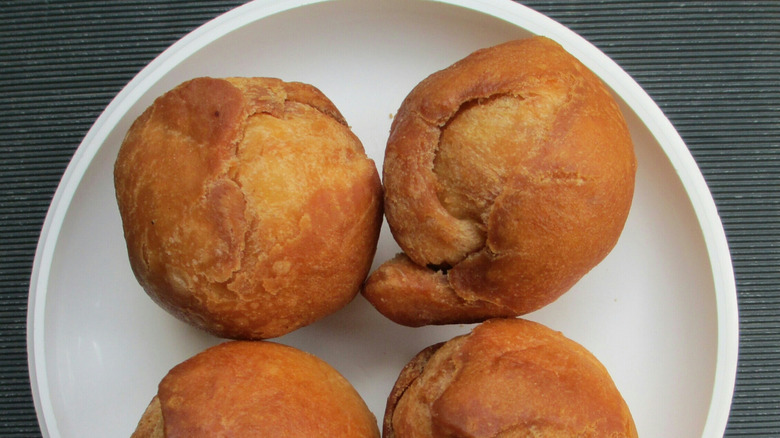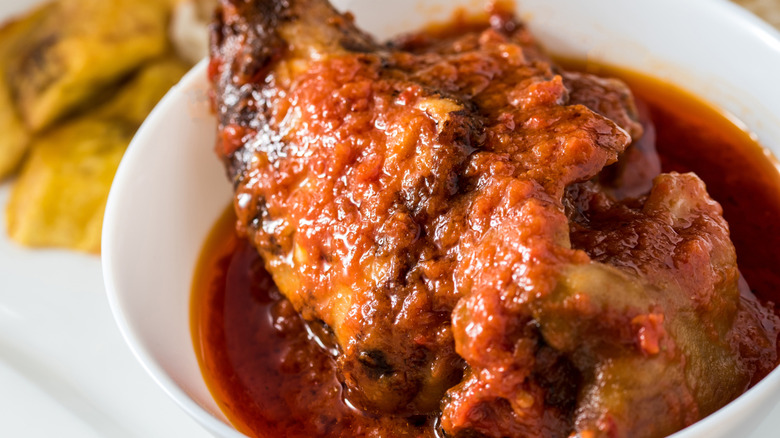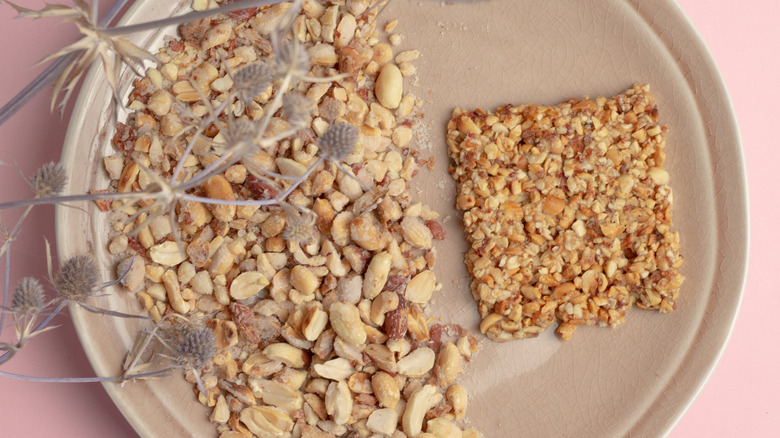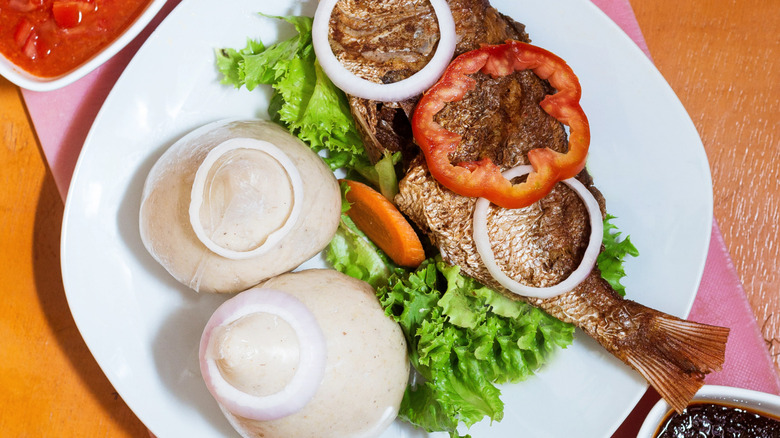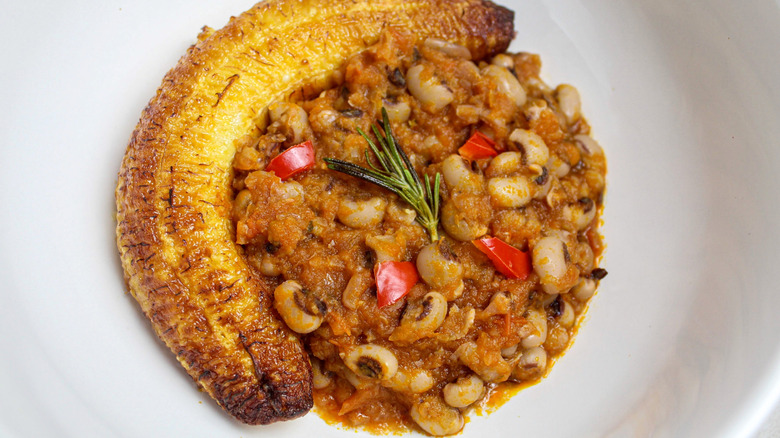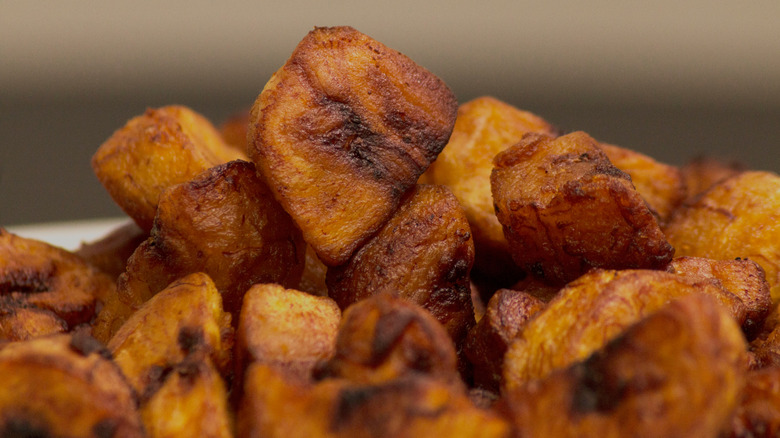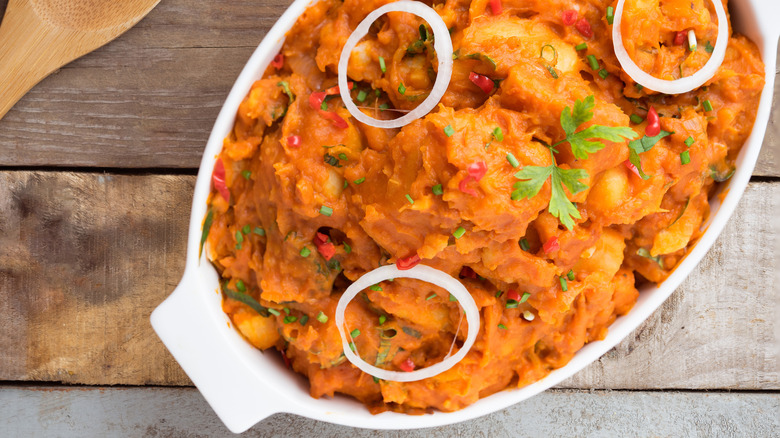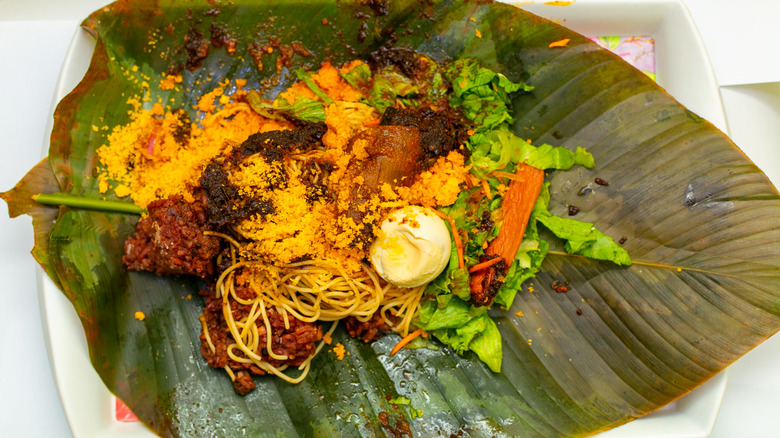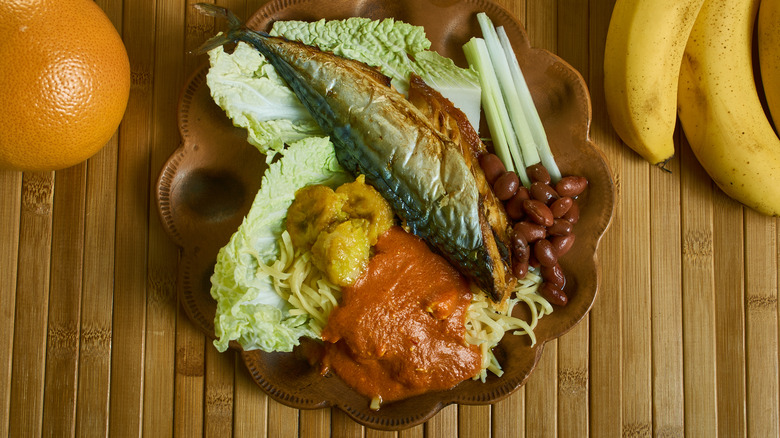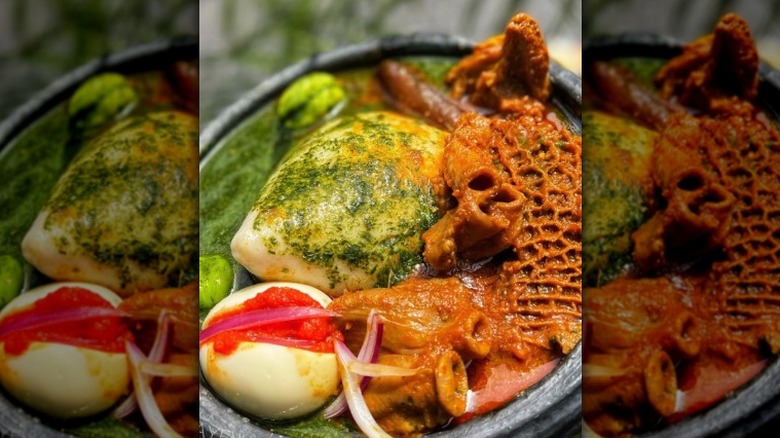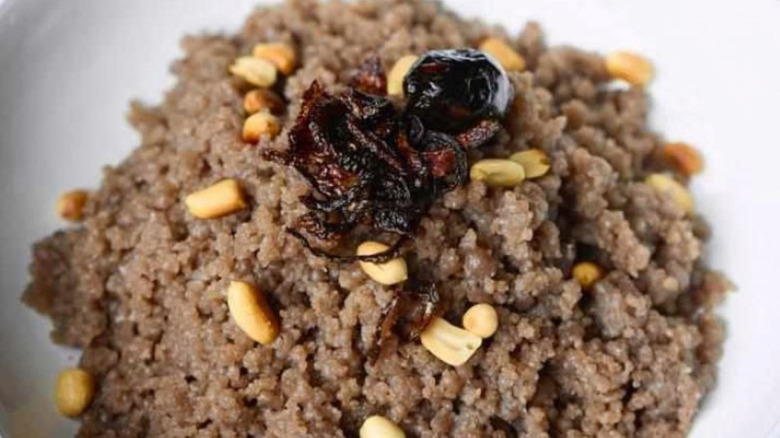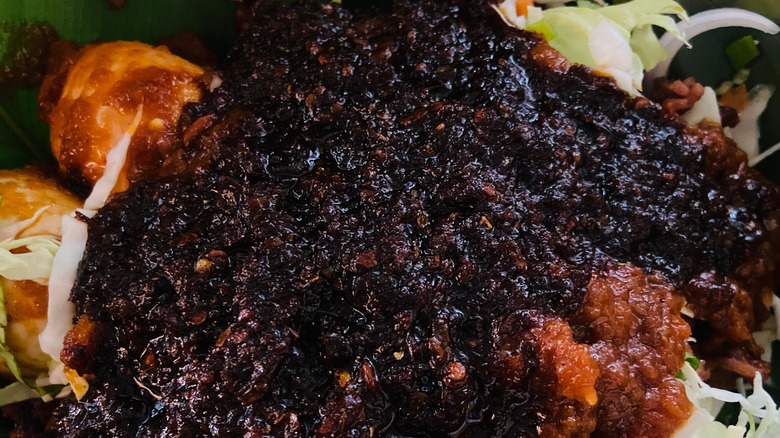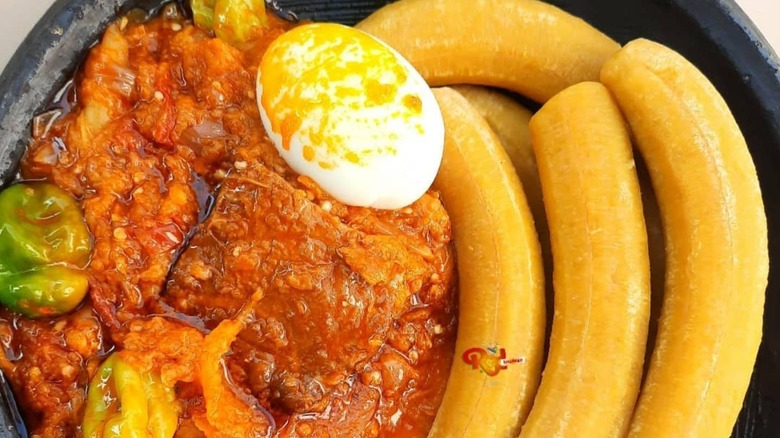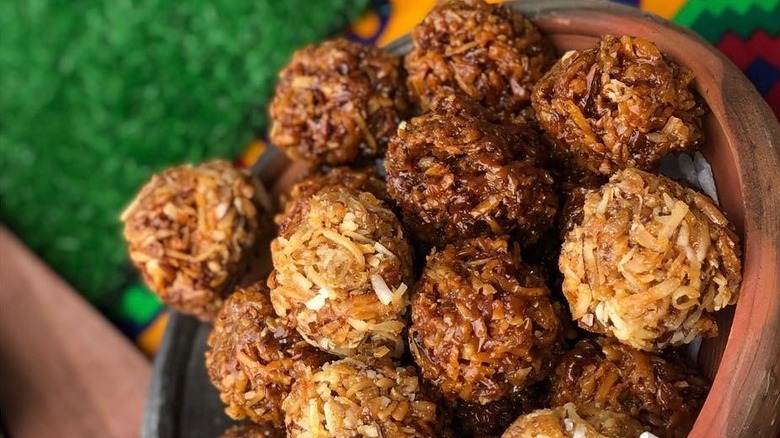20 Traditional Ghanaian Dishes You Need To Try At Least Once
We may receive a commission on purchases made from links.
Ghanaian food — like the culture and landscape of the country itself — is more varied and diverse than you may think. While the coastal West African nation isn't huge, it boasts a range of climates and ecosystems, from tropical forests to coastal savannah and deserts. These differing environments mean differing growing conditions and hunting/foraging opportunities, and this has led to distinct cuisines shaped by each region's crops and native flora and fauna.
A few signature features, however, seem to define Ghana's cuisine across regions. Hearty stews and soups are popular everywhere and all are vibrantly seasoned. Flavorings such as ginger, onions, and native spices such as calabash nutmeg and alligator pepper are generously used, as are vegetables such as bell peppers, greens, tomatoes, and okra. Legumes such as black-eyed peas are also staples and appear in a variety of dishes. And no meal would be complete without a hearty starch to soak up all the flavorful sauce or broth — either rice or swallows, which are hearty, mild mashes of cassava, rice, corn, or a mixture of these. In short, Ghanaian food offers plenty of opportunities for exploration. Here are some favorite dishes to look out for.
Peanut soup
Peanuts and other groundnuts (such as tiger nuts) have long been staples in African cooking and are used in many cuisines across the continent. In Ghanaian food, peanuts are not only enjoyed as snacks, but are common ingredients in breakfast dishes such as porridges, soups, and stews, where they provide body as well as flavor.
A popular Ghanaian dish that showcases peanuts is peanut soup, a savory concoction of ground peanuts (or peanut butter) thinned with water or broth and seasoned with tomatoes, ginger, garlic, peppers, and onions. The thick (but not completely smooth) soup is typically served with a choice of meat or seafood along with a starchy side, making it a substantial meal in itself. While this hearty and flavorful soup is a point of pride in Ghanaian food, variations with different ingredients and cooking methods occur across West Africa, which demonstrates the powerful, regional appeal of this dish.
Koko with koose
In Ghana, cooks and eaters take breakfast seriously. While Ghanaians with desk jobs might grab a coffee and some bread on the way out the door, their compatriots with more physically strenuous jobs take care to fortify themselves with a substantial morning meal. Thick, hearty porridges are common choices. Among these, the fermented corn porridge koko is especially esteemed. Made from cornmeal and water (and sometimes sweet, warm spices such as ginger and pepper) that are mixed together and allowed to ferment before cooking, the porridge has a distinctively tangy flavor from the fermentation, which eaters can complement (or tame) with the optional addition of sugar and/or evaporated milk.
Adding to the nutritional power of this breakfast dish is its traditional accompaniment, koose — crunchy, spiced fritters made from soaked, puréed black-eyed peas seasoned with ginger and Scotch bonnet chiles. While koose is a popular snack across West Africa in its own right (it's known in other countries as akara), it's considered an indispensable partner to the tangy-sweet porridge. Together, they not only offer an intriguing contrast of flavors and textures, but a meal substantial enough to keep you going strong all morning.
Fufu
Ghana is one of many West African countries that claim fufu as its own, and some authorities believe it originated there. Fairly bland by itself, this dense mash of cooked cassava and green plantains is so thick that eaters typically break off pieces of it with their fingers before dipping it into stews and soups.
Regional variations of fufu abound. While Ghanaians typically make theirs with cassava and green plantains, other ingredients, such as West African yam, are used further north. Cooks in other regions enhance their fufu with additional flavorings, such as salt, pepper, garlic, and even fried pork belly. Plain fufu is naturally cholesterol free, which makes it a good complement to balance out a rich, meaty stew or soup, and the fiber- and potassium-rich dish also aids in digestion. In some parts of Ghana, fufu is considered such a central and culturally important food that it's expected on the table every day.
Okra soup
Okra is native to West Africa, and African cooks were the first to make use of it, making the slender green pods the star ingredient in a number of favorite dishes. Indeed, the word okra itself has African roots and comes from the Igbo word for the vegetable, "ókùrù."
Ghanaian cooks prepare okra in a number of ways, but one of their best-known preparations is okra soup or stew. While the name suggests a basic vegetable braise, this vibrant dish is a meal in itself. To make it, cooks stew tomatoes, onions, garlic, chiles, and other seasonings (such as bouillon cubes or shrimp flavoring) in palm oil until soft. They then add broth and meat or seafood (beef is traditional, but smoked turkey, fish, or shellfish are other options) and simmer until the meat is cooked. Sliced or chopped okra is added last. If you dislike the slimy, viscous texture of cooked okra, you can avoid it by cutting the okra into large pieces and cooking it only briefly. If you want to use this texture to thicken your stew, chop your okra more finely and cook it longer, adding water if needed to reach your desired consistency.
Jollof rice
To a casual observer, jollof rice may look like a simple bowl of rice stained red by tomatoes, but there's more to this popular dish than meets the eye. Enormously popular across West Africa, Nigeria, Senegal, and Ghana all claim it as one of their national dishes. It is thought to have originated in Senegal (the word jollof refers to a kingdom that formed part of Senegal in the 12th century), where cooks prepared the dish — which in Senegal featured fish and rice, and optionally, tomatoes — during the French colonial era.
Good ideas tend to spread, and cooks in Nigeria and Ghana developed their own versions of jollof rice. In these versions, however, tomatoes are highlighted while fish is optional. A few regional differences distinguish Ghanaian jollof rice from that of Nigeria: While Nigerian cooks use long-grain rice, Ghanaian cooks prefer basmati or jasmine rice for a more tender texture. And, while Nigerian jollof rice is known for its spicy, hot-pepper kick and is often served with grilled or fried chicken, Ghanaian jollof rice is milder and sweeter and often served with plantains. Wherever it's served, the dish is a deeply loved comfort food.
Angwamu (oil rice)
Rice is popular in Ghana, especially in the southern regions of the country, and a number of Ghana's best-loved dishes showcase it. One of the simplest and most popular of these dishes is angwamu, or "oil rice." While this unassuming preparation looks like a pot of plain, boiled rice, it's loaded with flavor. It's made by frying onions (and sometimes other vegetables) in a generous amount of oil before stirring in the rice and some salt, covering it with water, and cooking it.
The simplicity of the dish not only makes it a good choice for novice cooks (or time-pressed, experienced cooks), but is part of why the dish has earned another nickname of baby rice — it's widely favored as a dish that's both mild and nutritious enough to feed to babies. Adult diners wanting a bit more punch to their meals customarily top their oil rice with hot pepper sauce and serve it with sardines, cooked eggs, or other proteins for a quick, hearty meal.
Bofrot
A love for fried dough seems to be nearly universal in the world's food traditions, and Ghana is no exception. A popular street food worth looking for (it won't be hard to find) is bofrot — small, round, fried yeasted doughnuts. While they're often eaten as snacks (sometimes with peanuts), some aficionados feel they're best for breakfast eaten straight from the fryer alongside a bowl of koko.
Variations of this snack are common across West Africa and go by a number of names — the Nigerian version of this doughnut is affectionately known as puff-puff. To make the doughnuts, yeast is mixed into a thick batter of flour, sugar, butter, vanilla, nutmeg, and cinnamon and allowed to rise until the batter is doubled in size and bubbly. Balls of the batter are dropped into hot oil and fried until golden brown. Some versions include eggs and milk in the batter, and some cooks top their bofrot with a sprinkling of powdered sugar. Like all fried doughnuts, bofrot are time consuming and messy to make at home, which is why most Ghanaians turn to experienced street cooks to satisfy their cravings.
Light soup
Light soup, which originated as a tomato and seafood soup created by fishing communities in the coastal regions of Ghana's capital, Accra, is only light in comparison to Ghana's other, super-hearty soup-stews (peanut soup, okra soup). While containing more think liquid by comparison, it's still substantial enough to make a meal on its own if served with one of Ghana's traditional starches such as fufu or rice.
While it's not super thick, it's certainly not light in flavor. The bold, tomato-based broth is spiced with habanero peppers, onions, and sometimes shrimp powder. While it originally was served with cooked seafood, once it gained popularity in other regions of Ghana, versions including meats such as spiced chicken, beef, or goat emerged. Today, the meat versions are just as popular, if not more so, than the seafood-based original. Some cooks also add eggplant or okra to make this dish even more substantial and flavorful.
Nkatie (peanut candy)
Nkatie is a textbook example of how creative cooks can accomplish a lot with very few ingredients. Made with nothing but chopped peanuts and sugar, nkatie is often referred to as peanut cake in Ghana, but is actually closer to a pared-down version of peanut brittle with a higher proportion of peanuts to sugar than American-style peanut brittle.
It's also so straightforward and simple to make that it's often among the first dishes Ghanaian girls learn to cook. To make your own nkatie, mix finely chopped peanuts into an equal weight of granulated sugar that has been cooked until golden. Once the peanuts and caramel have been combined, pour them quickly onto a greased cutting board and roll into a rectangle with a greased rolling pin. Working quickly, cut the mixture into diamonds while still warm and soft. The brittle will harden as it cools. This sweet treat is also sold in shops and by street vendors, and is often enjoyed at weddings as well as for everyday snacking.
Banku and tilapia
Because of Ghana's coastal location, the country has a rich tradition of seafood cookery. To satisfy the local appetite for fish in light of rapidly shrinking marine fish populations, the Ghanaian government has actively supported aquaculture, and the farming of freshwater fish such as tilapia — a local favorite — has exploded in recent years.
And, cooks in Ghana have devised flavorful ways to make use of tilapia. A simple and popular preparation often seen at roadside stands is to generously spice and then grill the fish, which is then served with a spicy blend of chopped hot peppers, tomatoes, and onion along with banku, a starchy mass of fermented cornmeal and ground cassava. A staple starch in the coastal regions of Ghana, banku serves the same role as fufu and is eaten the same way — pinches of it are dipped into or wrapped around more flavorful food to balance strong flavors and add bulk to the meal.
Red-red
Another quintessential Ghanaian dish worth seeking out is red-red, a flavorful and colorful stew of black-eyed peas cooked with palm oil and tomatoes, along with other flavorings including onions, ginger, and garlic. The dish is said to get its name from the bright red color contributed by both the palm oil and the tomatoes. Red palm oil, a key ingredient in the dish, comes from oil palms native to West Africa and is considered an essential ingredient in Ghanaian food and other West African nations. If you're concerned about the health risks of palm oil, it's worth noting that African-made red palm oil is minimally processed, more nutritious, and more sustainable (and flavorful) than the notorious white palm oil found in many processed foods.
While fully vegetarian versions of red-red can be made, it can also be cooked with seafood such as crayfish or smoked meat for an extra hit of flavor. If you want to add smokiness without adding meat, a dash of smoked paprika will do the trick. Red-red is traditionally enjoyed throughout the day. It can be a comforting and filling breakfast with bofrot on the side, as well as a hearty lunch when served with fried or boiled plantains or garri, which is dried cassava granules reconstituted with water to make a porridge or thicker mash.
Kelewele
Ghanaian cooks have a deep appreciation for carbs, and starchy, cooked plantains make regular appearances at the table. While plain boiled or fried plantains are commonly served alongside other, more assertively flavored dishes such as red-red or jollof rice, plantains don't always have to be bland background players in Ghanaian cooking. A case in point is kelewele, a favorite side dish and snack consisting of brightly spiced and fried plantain chunks. The sweet, spicy, crunchy chunks are flavorful enough to be a popular snack food in their own right.
And while this spicy treat is uniquely Ghanaian, it can be easily made with common supermarket ingredients in the U.S. To make it, cooks mix peeled chunks of ripe plantains with grated ginger, raw onions, and garlic, along with spices including cayenne, aniseed, nutmeg, and salt. After the chunks have absorbed the flavors (about 30 minutes), they're deep-fried until brown, then served hot. The combination of savory, hot spices and sweet, ripe plantain is what makes this a favorite snack in Ghana.
Yam pottage
It's time to settle the annual Thanksgiving debate once and for all: No, yams and sweet potatoes are not the same thing. True yams are large, starchy, tubers from vines native to Asia, West Africa, and South America, and unlike sweet potatoes, (which are tubers of an unrelated plant) are not sweet or orange. Upon arriving in the U.S., enslaved Africans came to refer to the sweet potatoes they encountered here as yams, since the word yam resembles the word for "eating" in many West African languages. Sweet potato growers followed suit, so the terms yam and sweet potato came to be used interchangeably.
Thus, when Ghanaian cooks refer to dishes with yams, don't expect anything sweet or orange to show up at the table. Instead, the true African yam commonly used in Ghanaian food will be white and starchy. It's often simply boiled and mashed to be served as a neutral starch alongside stews and soups, but it can also be a starring ingredient in spicy dishes such as yam pottage or yam porridge, a savory stew of yam chunks cooked with onions, garlic, shrimp powder, habanero chiles, bell peppers, and smoked fish. Palm oil and sometimes tomatoes can be included, as well as bouillon cubes for extra flavoring. This powerful combination of seasonings and local ingredients favored by Ghanaian cooks makes this not only deeply flavorful but a great representation of Ghana's rich cuisine.
Waakye
For a dish that is equally at home for breakfast, lunch, or dinner, try the traditional Ghanaian dish waakye. The name waakye comes from the Hausa phrase 'shinkafa da wake' which translates as rice and beans — two feature ingredients of this dish. These two simple staple ingredients are infused with rich, complex flavors from the spices they are cooked in, creating a delicious filling dish that has numerous variations across the country. Common spices used include ginger, scotch bonnet chilis, and paprika, so it is not a dish for the faint hearted. Of course, if you are preparing it at home you can tailor the spice level to suit your palate.
Though waakye itself may seem like a simple dish, it is the accompaniments that turn it into a feast, and they can be varied and plentiful. From stewed goat to fried plantains, and shrimp to roasted vegetables, this dish can take on many forms depending on which region of Ghana it is served in.
Though it can be eaten as a filling meal at any time of day, the people of Ghana love to eat waakye for breakfast. It is sold as street food, often on a banana leaf with the delicious layers piled high on top. Cooking the dish with sorghum leaves gives it the distinctive red hue to match the deep, smoky flavor. If you are a newcomer to Ghanaian food, waakye is sure to leave an impression on you, as a breakfast you won't forget in a hurry.
Kenkey and fried fish
If you have never tried the Ghanaian delicacy kenkey, you are in for a treat. Delicious dumplings made from fermented maize dough, they are often served alongside fried fish to make a substantial meal. The fermented nature gives the dumplings a tang, similar to sourdough bread, which pairs beautifully with perfectly fried fish.
There are two main types of kenkey — ga and fante. They originate from different tribes, and the main difference is that ga kenkey is fermented for two to three days before being wrapped in a husk of corn, whereas fante kenkey is fermented for a longer period of time and wrapped in plantain leaves instead. The dumplings are then steamed to perfection, before being served with fish and a spicy sauce made with peppers. Both types of kenkey are delicious served with fish such as tilapia or red snapper, though they will work well with any type of fish. This classic combination creates a filling dish that is rich with traditional Ghanaian flavors.
Tuo zaafi
Let's explore the ultimate in Ghanaian comfort food — in the hearty tuo zaafi. Referred to locally as TZ, it is a slow-cooked dish made from millet flour that is then served on top of a nutritious soup. It is prepared in a similar way to oatmeal, stirred in a pot until it forms a thick and gooey texture.
The most common soup to serve with tuo zaafi is ayoyo, made from jute leaves. These bitter green leaves are highly nutritious, making tuo zaafi a meal that will fill you up and nourish you at the same time. If you want to make tuo zaafi at home, spinach leaves can be substituted for ayoyo. Like most African food, ayoyo soup is filled with warming spices such as chilis, ginger, and star anise, giving it a deep flavor to accompany the hearty tuo zaafi. Tuo zaafi is a meal that brings families together in Ghana, as they enjoy home-cooked nourishing food and good company.
Wasawasa
While some users on TikTok say wasawasa is an unpopular Ghanaian food, it is super versatile and makes a wonderful base for a wide array of other ingredients. So, what is wasawasa? Well, it's similar to couscous (which is also from Africa) in terms of texture. However, instead of being made with semolina and water, it is made with water and yam flour, aka dried yam peels. Regardless of its popularity (or lack thereof), wasawasa is incredibly versatile — just like couscous. So, if you're looking to incorporate more Ghanaian food into your diet, it makes a great building block.
To make wasawasa, you start by adding a small amount of water to a bowl of yam flour. Then, you mix it with your hands until it starts to form small round clumps. When the texture comes together, the mixture is placed in a steaming pot and cooked for several minutes, often over a flame. After that, it is rinsed (maybe twice, if you feel inclined) and put back over the flame for about 10 more minutes until the texture is just right. In Ghana, it is typically paired with spicy sauces, beans, onions, and other vegetables or a protein. No matter how it's dressed up, though, it's filling, and the taste is similar to couscous or brown rice, so it takes to other ingredients with ease.
Shito aka shitor din
People around the world love hot sauce, and many countries have their own regional variations. You can probably think of quite a few, no problem. Shito, or shitor din, is the Ghanaian version of hot sauce. It is a spicy pepper concoction (with a touch of sweetness), and, as it turns out, it's quite popular. Maybe it's because it can be used as a sauce or condiment on just about anything. Or, maybe it's just because people love a bit of heat. Either way, it is definitely a Ghanaian food you need to try at least once. Unless, of course, you don't like spicy foods.
Shito is a dark, relish-like sauce that boasts a potent aroma and a deep, smokey, earthy flavor. Depending on how it's made, it can also have a fishy taste. In Ghana, every family has their own recipe for shito, but most recipes use a crayfish or smoked prawn powder to deepen and enrich flavor. In the United States, shrimp paste makes a fantastic substitute when traditional ingredients can't be found.
When it comes to adding shito to your collection of condiments, you don't have to make it from scratch unless you want to (it's not all that difficult). Still, for a newbie to the sauce, it may be best to simply snag a jar from Amazon — you can even find vegan shito on the site if that speaks to you.
Garden egg stew
Popular in Ghana, Nigeria, and other West African countries, garden egg stew is another hearty, brothy dish Ghanaian food claims as its own. As the name suggests, it is a stew made with garden eggs, but the fun doesn't stop there. Garden egg stew is also rich with tomatoes, onions, garlic, and ginger, giving it an abundance of rich, aromatic flavors. Some variations of the dish are vegan, but adding salted fish, smoked salmon, and/or smoked herring is also very common.
Before we get too ahead of ourselves, garden eggs may not be what you think — they certainly aren't eggs harvested from chickens living near a garden. Instead, garden eggs are a teardrop fruit similar to an eggplant or South American tomato. They can even have a pale color that makes them resemble actual eggs. If you are wondering why you've never heard of them or seen them before at the grocery store, it's because they are indigenous to Sub-Saharan Africa. Still, you can easily make garden egg stew at home with small eggplants. It won't be quite the same, but it gets you pretty darn close.
Kube cake
Kube cake is a chewy coconut candy, and while it is a favorite Ghanaian food, it's delicious enough that anyone could easily fall in love with its yummy taste and texture. For people from the Fante region of Ghana, kube is the word for coconut, so this tasty dish is aptly named. In fact, you don't need much else to put it together. In addition to coconut (ideally freshly shaved), lemon juice, water, and sugar are all that's needed to whip up a batch of sweet kube cake candies.
To make kube cake, shaved coconut, sugar, water, and a dash of lemon juice are cooked in a saucepan until caramelized. When all of the coconut is browned, the pan is removed from the heat source and placed in cool water to prevent further cooking. Next, the mixture, which should be quite sticky, is separated into small rounds and left to cool. The traditional way involves rolling the mixture into small balls with your hands, but a chilled spoon can also be used to scoop out rounded chunks. Either way, it's super easy. Sure, Ghanaians may add other things to spice kube cake up and make it their own, but in its base form, it's quite simple — so there's no reason not to give it a try at least once.

